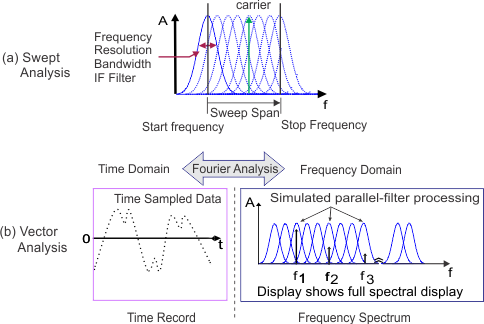VSA Measurement Advantages
VSA's measure dynamic signals and produces complex data results
The VSA offers some distinct advantages over swept-tuned analysis. One of the major advantages of the VSA is its ability to better measure dynamic signals. Dynamic signals generally fall into one of two categories: time-varying or complex modulated. Time-varying are signals whose measured properties change during a measurement sweep (such as, burst, gated, pulsed, or transient). Complex-modulated signals cannot be solely described in terms of simple AM, FM, or PM modulation, and include most of those used in digital communications, such as, quadrature amplitude modulation (QAM).
Swept-spectrum analyzers, in effect, sweep a narrowband filter across a range of frequencies, sequentially measuring one frequency at a time. Unfortunately, sweeping the input works well for stable or repetitive signals, but gives misleading results for signals that change during the sweep. Also, this technique only provides scalar (magnitude only) information, though some other signal characteristics can be derived by further analysis of spectrum measurements.

(a) Swept-Tuned Analysis displays the instantaneous time response of a narrowband IF Filter to the input signal. (b) Vector Analysis uses FFT analysis to transform a set of time domain samples to frequency domain spectra.
The VSA measurement process simulates a parallel bank of filters and overcomes swept limitations by taking a "snapshot", or time-record, of the signal; then processing all frequencies simultaneously. For example, if the input is a transient signal, the entire signal event is captured (meaning all aspects of the signal at that moment in time are digitized and captured); then used by the FFT to compute the "instantaneous" complex spectra versus frequency. This process can be performed in real-time, that is, without missing any part of the input signal. For these reasons the VSA is sometimes referred to as a "Dynamic signal analyzer" or a "Real-Time signal analyzer". The VSA's ability to track a fast-changing signal isn't unlimited however; it depends on the VSA's computational capability.
The VSA decreases measurement time
Parallel processing yields another potential advantage for high-resolution (narrow frequency span) measurements—faster measurement time. If you've used a swept-tuned spectrum analyzer before, you already know that narrow resolution bandwidth (RBW) measurements of small frequency spans are very time-consuming. Swept-tuned analyzers sweep frequencies from point to point slowly enough to allow the analog resolution bandwidth filters settle; by contrast, the VSA measures across the entire frequency span at one time. However, there is analogous VSA settling time due to the digital filters and DSP. This means the VSA sweep speed is limited by data collection and digital processing time rather than analog filters. But this time is usually negligible when compared to the settling time of analog filters. For certain narrow-bandwidth measurements, the VSA can complete a measurement up to 1000 times faster than conventional swept-spectrum analyzers.
In a swept-spectrum analyzer, the physical bandwidth of the sweeping filter limits the frequency resolution. The VSA doesn't have this limitation. Some VSA's can resolve signals that are spaced less than 100 µHz apart. Typically, in VSA's, the resolution is limited only by the amount of time you are willing to devote to the measurement. Increasing the resolution also increases the time it takes to measure the signal—the length of the required time-record.
Time-capture is a great tool for signal analysis and troubleshooting
Another feature that is extremely useful is the time-capture capability; this allows you to record actual signals in their entirety without gaps and replay them later for any type of data analysis. The full set of measurement features can be applied to the captured signal. For example, you could capture a transmitted digital-communications signal and then perform both spectrum and vector-modulation analysis to measure signal quality or identify signal impairments.
DSP provides multi-domain measurements in one instrument
The use of digital signal processing (DSP) also yields additional benefits; it provides time, frequency, modulation, and code domain measurement analysis in one instrument. Having these capabilities increases the analyzers value to you and improves the quality of your measurements. FFT analysis allows easy and accurate views of both time and frequency domain data. The DSP provides vector-modulation analysis, including both analog and digital modulation analysis. The analog demodulator produces AM, FM and PM demodulation results, similar to that of a modulation analyzer, allowing you to view amplitude, frequency and phase profiles versus time. The digital demodulator performs a broad range of measurements on many digital communications standards (such as NADC, cdma2000 and more) and produces many useful measurement displays and signal quality data.
Although the VSA clearly provides important benefits, the conventional analog swept-tuned analyzers can provide higher frequency coverage and increased dynamic range capability.
